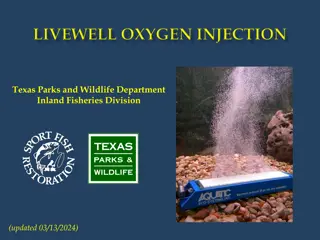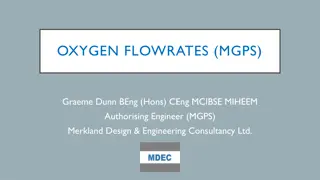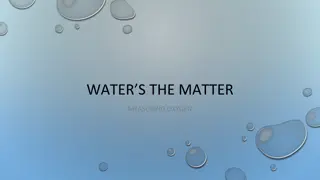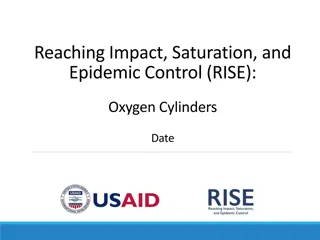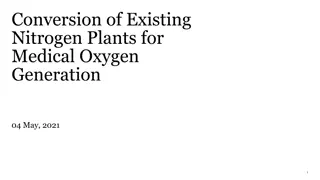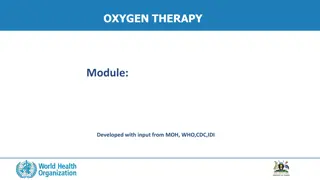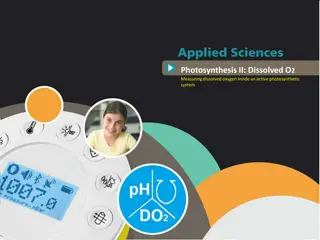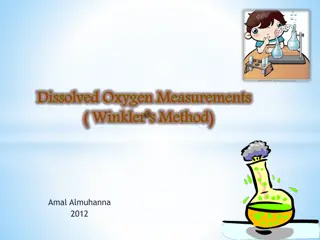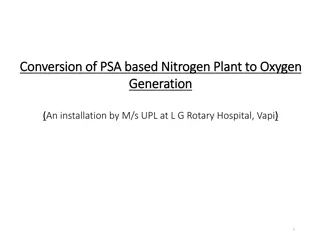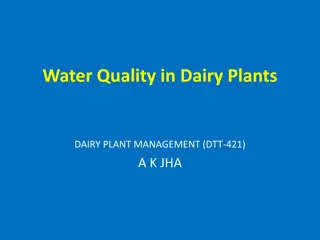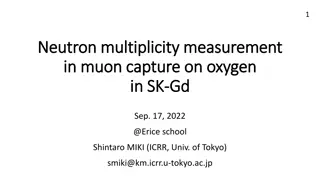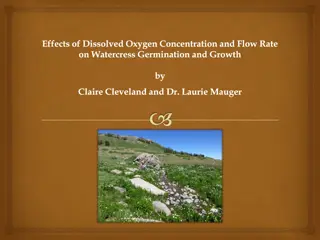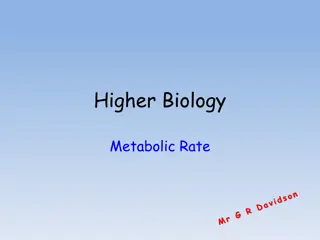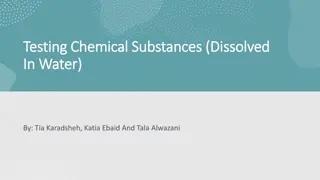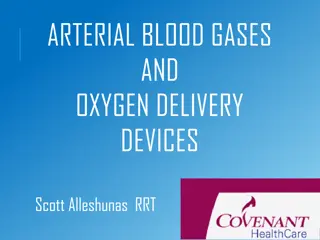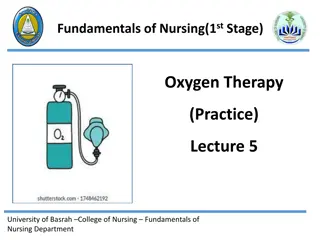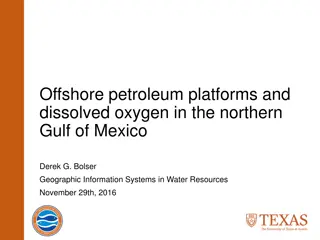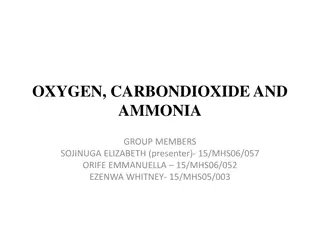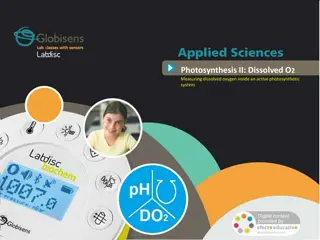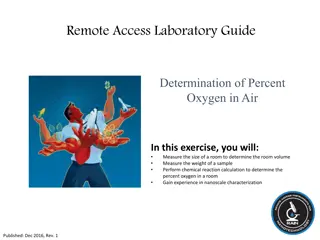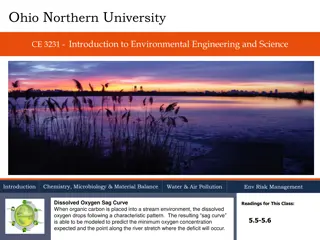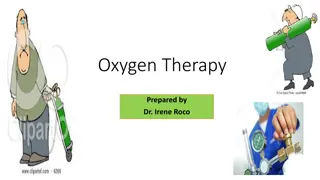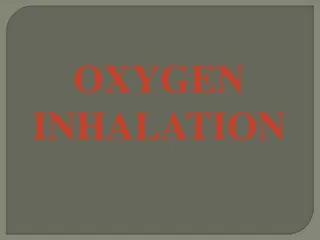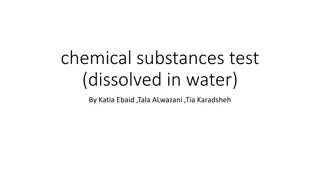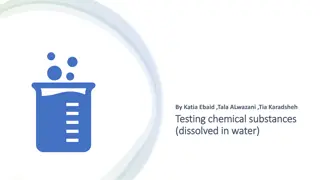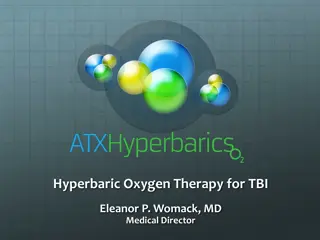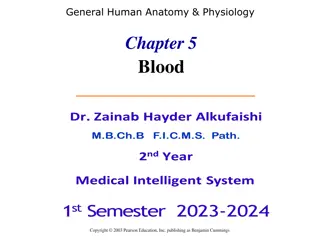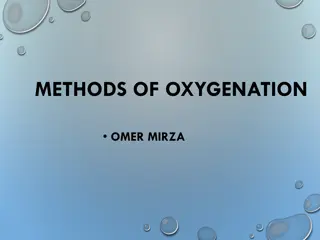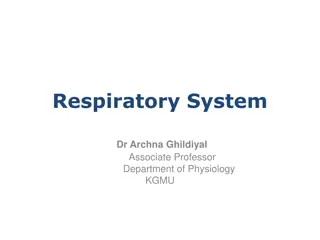Essential Medical Oxygen: Supply and Safety Guidelines
Medical oxygen is crucial in healthcare, especially during the COVID-19 pandemic. This resource explains its importance, use in various treatments, safety measures, and storage requirements. Learn about the significance of high-grade oxygen and the process of oxygen therapy delivery. Enhance your un
2 views • 48 slides
Understanding Oxygen Diffusion Rate Measurement in Plant Roots
Measurement of oxygen diffusion rate in plant roots is crucial for assessing soil oxygen levels and aeration conditions. The Oxygen Diffusion Rate (ODR) method utilizes a platinum microelectrode to simulate roots, allowing for the calculation of oxygen flux at the root-soil interface. By monitoring
1 views • 5 slides
Dissolved Oxygen Measurements and Factors Affecting Oxygen Levels
Understanding the importance of dissolved oxygen in water is crucial for the survival of aquatic plants and animals. Factors such as chemical reactions, temperature, pressure, and light penetration influence oxygen levels. The Winkler method is commonly used for dissolved oxygen measurements. This m
4 views • 11 slides
Maintaining Dissolved Oxygen Levels for Black Bass in Livewells
Dissolved oxygen is crucial for the health of black bass in livewells, especially during warmer months. This presentation explores the importance of oxygen equipment to maintain sufficient oxygen levels, recommends system components, and provides guidelines for installation, operation, and safety me
0 views • 14 slides
What is TDS
TDS stands for Total Dissolved Solids, a crucial parameter in water quality assessment. It refers to the combined content of all inorganic and organic substances dissolved in water. These substances can include minerals, salts, metals, ions, and other organic compounds.
0 views • 7 slides
Evolution of Oxygen Flowrates in Healthcare Settings
Discussions around oxygen flowrates in healthcare facilities, especially in the context of the COVID-19 pandemic, highlight the need for a review of current guidelines. The existing (S)HTM 02-01 guidance, developed around 20 years ago, is being reevaluated to align with modern clinical practices. Pr
0 views • 11 slides
Exploring Dissolved Oxygen in Water: Importance and Impact
Delve into the world of dissolved oxygen in water, understanding its significance in measuring water quality in aquatic environments. Discover factors affecting dissolved oxygen levels, interpret data, and explore the impact of human activities on water quality.
0 views • 52 slides
Understanding Cellular Respiration and Oxygen Delivery
Cellular respiration, a vital process for organ survival, involves mitochondria performing cellular respiration by utilizing glucose and oxygen. Glucose is derived from diet or body breakdown, while oxygen enters through the respiratory system, facilitated by red blood cells in the circulatory syste
0 views • 8 slides
Importance of Transport System in Animals for Oxygen Supply
Animals require a transport system to meet tissue oxygen demands efficiently. The size limit for oxygen diffusion alone is around 1 mm due to the proportional increase in radius and diffusion properties. Blood is crucial for transporting oxygen, nutrients, waste products, cells, and heat, as well as
0 views • 17 slides
Comprehensive Guide to Oxygen Storage and Handling Methods
Explore the various methods of storing and handling oxygen, including types of storage devices, sources of medical oxygen, liquid oxygen containers, and cryogenic liquid cylinders. Learn about the different containers used, storage quantities, vaporization rates, and safety measures involved in stor
0 views • 61 slides
Conversion of Nitrogen Plants for Oxygen Generation in Medical Industry
CPCB has identified industries with nitrogen plants that can be converted to produce oxygen without impacting normal operations. Conversion involves using Zeolite Molecular Sieve and PSA technology, with M/s. UPL Ltd successfully converting a plant at LG Rotary Hospital in Gujarat within 72 hours. S
0 views • 15 slides
Importance of Oxygen Therapy in Managing Respiratory Illnesses
Oxygen therapy is crucial in treating hypoxemia and saving lives, especially in patients with severe acute respiratory infections like COVID-19. This module covers the significance of oxygen therapy, indications for its use, methods to measure blood oxygen levels, and how to titrate oxygen therapy e
2 views • 22 slides
Oxygen Therapy in Veterinary Practice
Oxygen therapy is a crucial intervention in veterinary medicine, especially in emergency situations to address hypoxia and increase oxygen delivery to tissues. It involves delivering high concentrations of oxygen to optimize oxygen levels in the blood. Indications for oxygen therapy include hypoxia
1 views • 15 slides
Understanding Photosynthesis and Measuring Dissolved Oxygen
Explore the process of photosynthesis and the importance of dissolved oxygen within a photosynthetic system. Discover how environmental factors like light intensity influence the rate of photosynthesis, and learn how to measure dissolved oxygen using the SensorLab air pressure sensor. Engage in an e
0 views • 22 slides
Dissolved Oxygen Measurement and Factors Affecting Oxygen Levels
The content highlights the importance of measuring dissolved oxygen levels in water bodies for aquatic life survival. It explains the factors influencing oxygen concentrations, the principles of Winkler's method for measurement, required materials, and the testing procedure involved. The significanc
0 views • 11 slides
Conversion of Nitrogen Plant to Oxygen Generation at L.G. Rotary Hospital, Vapi
Transformation of a PSA-based nitrogen plant into an oxygen generation system at L.G. Rotary Hospital in Vapi. The process involves utilizing PSA technology with a specific operation philosophy, molecular sieve types for O2 and N2 generation, and various modifications to adapt the plant for oxygen p
0 views • 6 slides
Understanding Water Quality in Dairy Plants
Water quality plays a crucial role in dairy plant management. Impurities in water, including organic matter, dissolved gases, and mineral salts, can impact the overall quality. This article delves into the various aspects of water quality, such as dissolved and suspended matter, colloidal suspension
0 views • 14 slides
Neutron Multiplicity Measurement in Muon Capture on Oxygen in Super-Kamiokande
Explore the neutron multiplicity measurement in muon capture on oxygen using Super-Kamiokande, a water-Cherenkov detector located underground in Japan. Gadolinium was added to enhance neutron tagging efficiency, aiding in Supernova observation, proton decay rejection, and more. Neutron signals are t
0 views • 16 slides
Shallow Habitats Data Analysis & Project Updates
Conducting initial data analysis in shallow habitats to understand factors affecting phytoplankton composition and dissolved oxygen levels. Priority issues include assessing biomass signals, harmful algal blooms, and the role of nutrients. Key questions focus on low dissolved oxygen impact on fish a
0 views • 24 slides
Impact of Dissolved Oxygen and Flow Rate on Watercress Germination and Growth
A study by Claire Cleveland and Dr. Laurie Mauger explores the effects of dissolved oxygen concentration and flow rate on watercress germination and growth. The research includes ecological markers, existing evidence, hypothesis, experimental design, and anecdotal results indicating that watercress
0 views • 15 slides
Understanding Salinity in Seawater: Density, Composition, and Variations
Seawater is denser than freshwater due to dissolved mineral matter, contributing to its salty flavor. Salinity, measured in ppt, indicates the grams of minerals per kg of seawater. The average salinity is 35 ppt, varying between 33-38 ppt. Distillation is essential to purify water by removing dissol
1 views • 31 slides
Understanding Metabolic Rate in Biology: Measurement and Importance
Metabolic rate, the energy consumed by an organism in a specific time period, can be measured through heat energy, oxygen consumption, and carbon dioxide release. Various tools like calorimeters and respirometers are used for this purpose. The delivery of oxygen through efficient transport systems i
0 views • 28 slides
Exploring Chemical Substances: Dissolved in Water
This article delves into the properties of various chemical substances when dissolved in water, including Calcium Carbonate, Sodium Carbonate, Iron Oxide, Magnesium Sulfate, and Potassium Chloride. It discusses the exothermic and endothermic reactions that occur during dissolution, along with the ch
0 views • 6 slides
Integrated Terrestrial-Coastal Ocean Framework for Carbon Management
An advanced framework integrating terrestrial and coastal ocean observations and modeling is developed to support carbon management decisions. The study focuses on assessing the impacts of land use, human activities, and climate scenarios on the carbon cycle, particularly dissolved inorganic carbon
0 views • 5 slides
Understanding Arterial Blood Gases and Oxygen Delivery Devices
Arterial blood gases (ABG) are obtained from arteries to assess acid-base balance and blood oxygen levels. The pH, PaCO2, PaO2, HCO3, and SaO2 are crucial values on an ABG report. These values reflect the blood's acid-base status, carbon dioxide levels, oxygen saturation, and more. The buffer system
0 views • 25 slides
Oxygen Therapy: Fundamentals and Practice Overview
Oxygen therapy is a vital intervention for individuals with respiratory conditions like COPD, pneumonia, asthma, and more. This practice involves administering supplemental oxygen to improve oxygen levels in the body, leading to enhanced energy levels and overall quality of life. Precautions and con
0 views • 28 slides
Study on Offshore Petroleum Platforms and Dissolved Oxygen in the Northern Gulf of Mexico
This study explores the relationship between offshore petroleum platforms and dissolved oxygen levels in the northern Gulf of Mexico. It aims to quantify platforms within hypoxic zones and assess the total hypoxic area using data from various sources. The findings provide insights on marine habitat
2 views • 14 slides
Understanding Oxygen: Uses, Effects, and Importance in Living Organisms
Oxygen, a vital nonmetallic element, plays a crucial role in various processes essential for living organisms. It is involved in energy production, metabolism, immune system support, and more. However, the lack of oxygen can lead to serious conditions like hypoxia. Learn about the uses, effects, and
0 views • 37 slides
Exploring Photosynthesis: Measuring Dissolved Oxygen in Photosynthetic Systems
Discover the significance of dissolved oxygen in photosynthesis and how environmental factors like light intensity influence the process. Engage in hands-on experiments to investigate the impact of varying light conditions on oxygen availability and photosynthetic rates.
0 views • 22 slides
Determining Percent Oxygen in Air Lab Guide
This laboratory exercise focuses on determining the percentage of oxygen in air through room volume measurement, sample weight analysis, and chemical reaction calculations. The background information covers the importance of oxygen, historical discoveries, combustion reactions, and the debunking of
0 views • 12 slides
Understanding Dissolved Oxygen Sag Curves in Environmental Engineering
Understanding the Dissolved Oxygen Sag Curve in streams is crucial for predicting oxygen depletion due to organic carbon input. Models like the Streeter-Phelps Model help in estimating minimum oxygen levels and distance downstream where deficits occur. This involves concepts like BOD, DO, mathematic
0 views • 14 slides
Oxygen Therapy in Emergency Medicine
Oxygen therapy is crucial in emergency medicine for treating hypoxemia and improving oxygenation levels in patients. It is essential for conditions like acute hypoxemia, carbon monoxide poisoning, and shock. Various oxygen delivery devices are used to administer oxygen effectively, such as nasal pro
0 views • 27 slides
Comprehensive Guide to Oxygen Therapy and Safety Precautions
Oxygen therapy is a crucial medical intervention for various conditions, such as hypoxia, impaired gas exchange, and heart failure. This guide covers the administration of oxygen, types of oxygen supply, safety precautions, and devices used for oxygen delivery. Safety measures include avoiding smoki
0 views • 16 slides
Understanding Oxygen Inhalation in Medical Treatment
Oxygen inhalation is a vital medical intervention to treat low blood oxygen levels in children with respiratory issues. It helps manage hypoxia, maintain oxygen levels in the blood, and support normal cellular function. Common indications include cyanosis, breathlessness, anemia, and exposure to low
0 views • 44 slides
Exploring Chemical Reactions: Testing Substances Dissolved in Water
Explore the fascinating world of chemical reactions by testing various substances dissolved in water. Discover how salt, sugar, baking soda, borax, and vinegar interact with water, leading to endothermic or exothermic reactions with unique properties and uses.
0 views • 6 slides
Testing Chemical Substances Dissolved in Water
Explore the effects of salt, sugar, baking soda, borax, and vinegar when dissolved in water. Discover their properties, reactions, and practical applications, shedding light on endothermic and exothermic reactions in aqueous solutions. Delve into the chemical compositions and behaviors of these comm
0 views • 6 slides
Hyperbaric Oxygen Therapy for Traumatic Brain Injury (TBI) - Benefits and Mechanisms Explained
Hyperbaric Oxygen Therapy (HBOT) is a cutting-edge treatment that involves providing oxygen in a pressurized environment to enhance oxygenation of body tissues beyond what red blood cells can deliver. This therapy, administered under controlled conditions, offers various physiological and cellular b
0 views • 15 slides
Understanding Blood: Composition and Functions
Blood is a vital fluid tissue in the human body, classified as a connective tissue. It consists of living cells known as formed elements suspended in a non-living matrix called plasma. The physical characteristics of blood, such as color range, pH level, and temperature, play crucial roles in mainta
0 views • 33 slides
Comprehensive Guide to Oxygenation in Respiratory Care
Oxygenation is a vital aspect of medical care, involving the process of delivering oxygen to the body's cells. It includes measures such as Arterial Oxygen Saturation, Oxygen Delivery, Oxygen Consumption, and Oxygen Extraction. Understanding hypoxia and hypoxemia, as well as the mechanisms of hypoxe
0 views • 28 slides
Understanding Oxygen Transport in the Respiratory System
Explore the intricate process of oxygen transport in the respiratory system, covering topics such as the composition of air, gaseous transport, factors affecting oxygen-hemoglobin dissociation, atmospheric air composition, diffusion of gases, effects of water vapor, and the methods of oxygen transpo
0 views • 37 slides



